When Garage Door Closes Does Need to Wait Before Opening Again
December 15, 2021 Posted in: Garage Doors
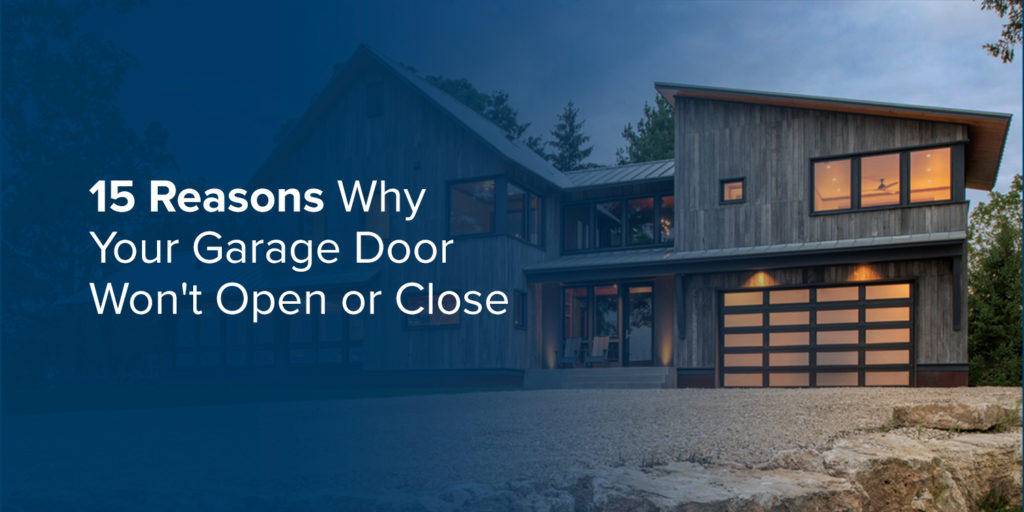
As the most frequently used entrance and exit in the average residential home, the garage door is subject to daily wear and tear. Consequently, a garage door is bound to have functional issues every now and then. Problems are most common in the winter when power outages occur. Homeowners in North Carolina and surrounding areas are all-too-familiar with such problems.
Call 336-813-2601 Now For Repair Services
When a garage door won't function properly, the source of the problem could be in any number of given areas. Whether you have a garage door that won't open all the way or a garage door that won't open manually, it is best to know the most common causes of each problem and whether it is necessary to call a professional. Below are the 15 most common reasons why overhead doors won't open or close:
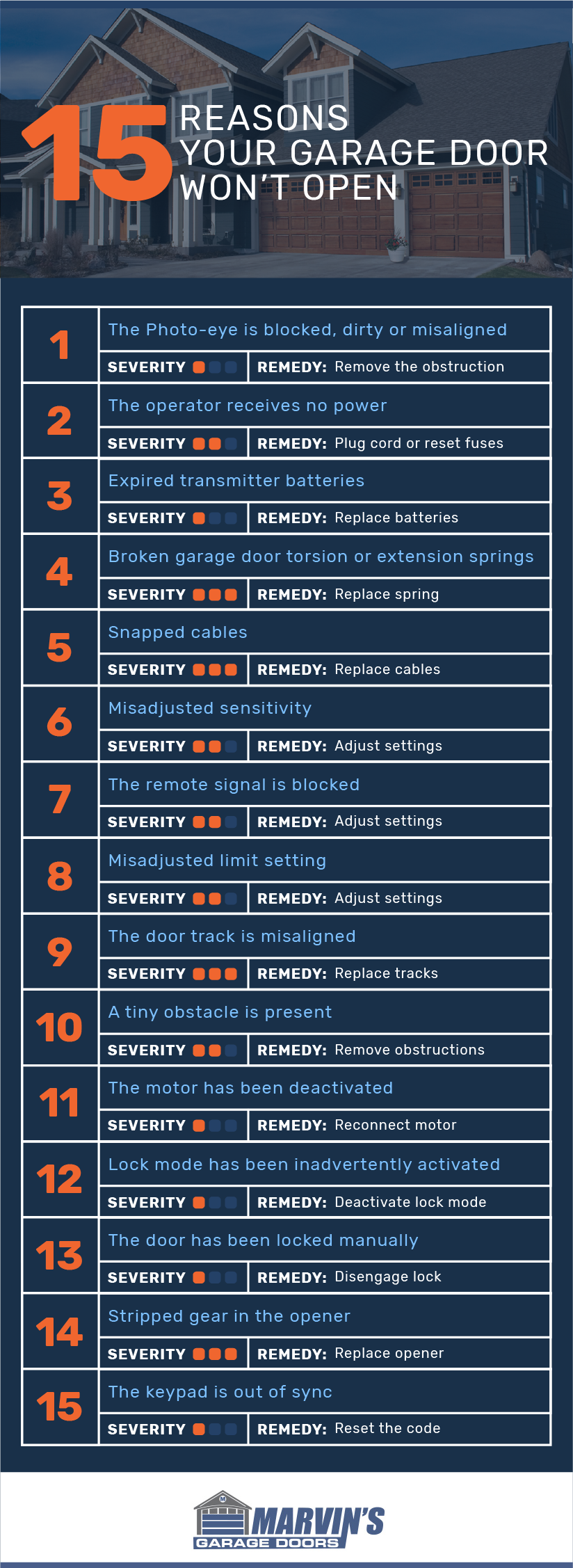
1. The Photo-Eye Is Blocked, Dirty or Misaligned
If your garage door keeps stopping and won't close all the way, the problem could be due to a blocked photo-eye. The majority of garage doors manufactured since the early-1990s are equipped with this safety feature.
The photo-eye components consist of two pieces that align face-to-face across each side of the garage door, roughly four feet above the ground. Upon activation, a pea-sized laser beam is sent from one end to the other.
A miscellaneous object or dirt is most likely the culprit for your blocked photo-eye's safety sensors. Your sensors could also be misaligned. You can easily fix the problem by removing the obstruction or calling a service to have your photo-eye realigned properly.
Each time the door is prompted to close, the beam activates to scan the underlying clearance for obstructions. If any type of object or body part is detected, the door either halts its closure or reverses in full. The purpose of the photo-eye is to ensure the door does not close down on objects, pets or people.

As a safety mechanism, the photo-eye is programmed to respond instantly to any obstruction. Consequently, the slightest bit of anything — such as a pencil or a wad of paper — can trigger the photo-eye to halt the movement of the door.
In some cases where a garage door won't close, the photo-eye will simply be dusty or dirty, and the dirt will be misinterpreted by the laser as a physical obstruction. There is also the possibility that the circuitry of the photo-eye has been damaged or saturated with moisture or rain.
With some non-closing garage doors, the problem is due to a misalignment issue between the two photo-eyes. When the two sides interact, LED lights activate on both ends. On most garage door systems, the corresponding photo-eyes will consist of one red light and one green light. If either light becomes misaligned with the other, the beam is rendered incapable of scanning the clearance. Photo-eyes can become misaligned by fatigue, physical pressure, etc.
2. The Operator Receives No Power
Sometimes, a garage door won't open or close for one reason only — the garage door operator has no power connection. In the funniest of scenarios, the problem will simply be due to an unplugged power cord. You might have absentmindedly unplugged the operator as you were exiting the garage through your internal door to the house. People sometimes do such things and forget having done so.
Often, a more serious issue will prevent an operator from receiving power, such as a blown fuse or circuit breaker. Problems with the circuit breaker should only be handled by a professional.
To summarize, if you're having trouble with your garage operator, it's probably either unplugged or it may have blown a fuse. You can plug the cord back in or have a professional service reset your fuses.
The issue could even be due to a faulty outlet. If you plug an electric tool or lamp into the socket, and that also fails to power, the outlet is likely the culprit — in which case the operator just needs to be plugged in elsewhere until the faulty outlet is repaired.
3. Expired Transmitter Batteries
When it comes to the activation of a garage door, power access is required at both ends. As such, the operator is not the only component that could possibly be robbed of a power source. If your garage door won't open with remote activation, the problem could be the result of an expired battery in your remote transmitter.
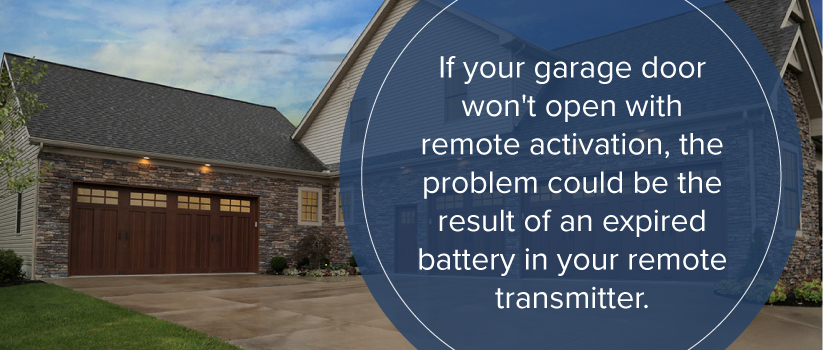
The first thing to check is the transmission receiver on the inside wall of your garage. When you manually push the button on the receiver, does the door activate? If yes, the problem is the remote and not the receiver.
A dead transmitter remote is a minor problem but a common reason your garage door might not open — often, the batteries have simply died. If your garage door remote doesn't work, you can replace the batteries, and it should return to working normally.
In cases like these, you are basically in luck because the remedy involves a simple change of batteries. If the batteries in your remote came pre-installed and you have never changed them before, simply slide off the back cover on the remote, remove the old batteries and take them to the store to purchase replacements of the same size. On some remotes, removal may require a screwdriver if a locking component is used to hold the batteries in place.
Before you install the new batteries, check the battery tips to ensure the ends align properly inside. If the remote were to malfunction due to a backward battery installation, you might mistake this for a more serious problem with your garage door opener.
4. Broken Garage Door Torsion or Extension Springs
If your motor is still running but the garage door refuses to open, then you may have an issue with the springs in your garage door assembly. Broken springs are the most common issue at hand whenever a service person is called to a residence to repair a garage door.
Contact Us for Garage Door Spring Repair
Broken springs are one of the most dangerous yet inevitable problems that can occur with a garage door opening system, too. Each assembly is usually guided by torsion or extensions springs. Torsion springs are located horizontally along the width of the garage door, whereas extensions springs are located on either side and raise and lower the door along its tracks.
Each spring is rated according to its maximum number of cycles. Once a spring has exhausted its cycles, it needs to be replaced. Springs that are used beyond their cycles are prone to snap abruptly in the midst of a door activation. In some cases, a spring will break before its expiration date. Either way, spring ruptures are loud and dangerous.
If a spring breaks while you are at home, you will likely hear a loud pop resembling that of a firecracker or gunshot. Springs often break as homeowners head to work and close their garage doors remotely from their departing cars. If that is the case, count yourself lucky, as you will have missed the alarming sound.
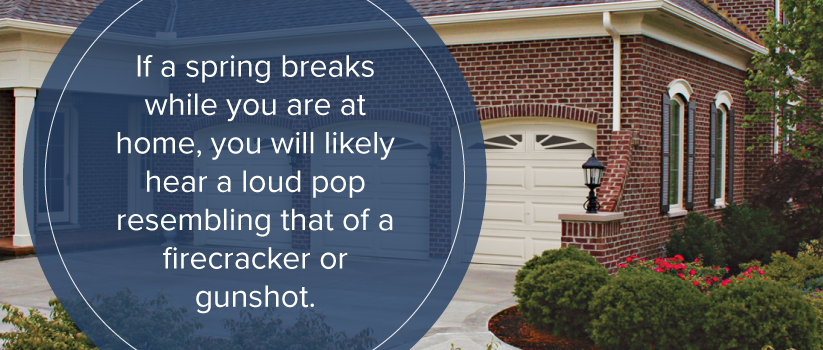
In any case, do not attempt to manually open or activate your garage door if one of the springs has broken. Furthermore, do not attempt to fix or even handle a broken torsion or extension spring. Contact a service specialist immediately to handle any issues that involve faulty or broken garage door springs.
5. Snapped Cables
If there is one problem even more dangerous than broken springs on a garage door assembly, it would be a broken cable. While the extension springs provide tension as the door is raised and lowered, the cables that align with each tension spring are responsible for the physical act of bringing the door up and down.
Cables, like springs, are fundamental parts of your garage door. Without a cable, your door is unsupported and can fall back to the ground. Always rely on a professional service come to repair and replace your cables.
Once the springs have snapped, the cables are the only things preventing the door from slamming to the ground with all of its weight. Aside from the thunderous noise this would cause, the door could sustain tremendous damage if it plunged to the ground. Moreover, anything in the door's path — a bicycle, the hood of an automobile, a child or a pet — could be crushed or severely damaged or injured from the weight of the door.
Garage Door Spring Repair Services
Most scary of all, cables generally do not last long once the springs have snapped. Therefore, if you know your extension springs have already failed, close the door and do not open it — not even manually — until you have those springs replaced. If you raise it just once, the cables could fail. Without the support of garage door cables, none of the opener's protective mechanisms will stop the door from its plunge.
6. Misadjusted Sensitivity
A garage door stuck closed is often the result of misadjusted sensitivity settings. This is a common problem on newly installed garage doors, where the opener might be set to an arbitrary factory setting that doesn't suit the door in question.
Bad setting inputs can create misadjusted sensitivity on your garage door. For this issue, it's smart to call a service to get your settings right and avoid future problems.
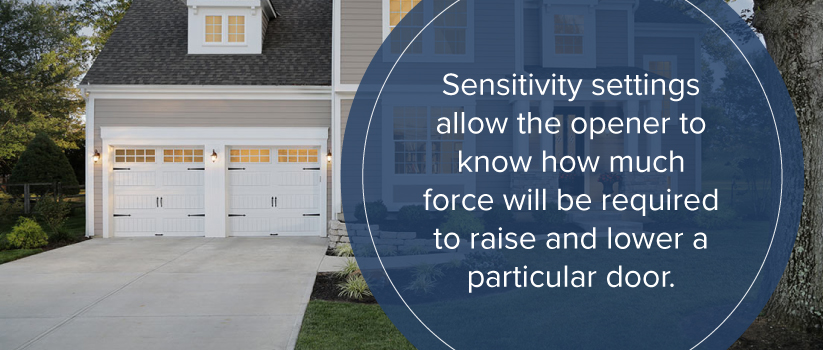
Sensitivity settings allow the opener to know how much force will be required to raise and lower a particular door. If the settings are off, the opener will be tricked into thinking that the door is either too lightweight to require force or too heavy for the weight-allowance of the opener. Consequently, the opener will not react to activation prompts if the settings are off and the garage door won't close.
7. The Remote Signal Is Blocked
A dead battery is not the only issue that can prevent a remote from doing its job. If you press the button and the door fails to activate, something might be blocking the signal. Alternately, you might be out of range. There is also the possibility that the remote antenna on the opening device has been obstructed or damaged.
Tree growths, obstructions or dirt can affect your garage's remote signal. In minor cases, you can simply trim a branch or clean off the antennae, and it should work fine. For broken antennas, you'll have to call a service.
If your garage door won't open when you press the remote, there could be a branch or some other intervening object obstructing the signal. Sometimes, a remote will cease to work from a particular angle because of tree growth. If your remote no longer works from the same angles you have always used it and changing the batteries doesn't help, it could be time to trim back some branches.
Then again, the obstruction could be directly on the remote antenna. You can often remedy this situation by inspecting the antenna for traces of dirt or foreign matter. Also, make sure the antenna is pointed toward the door. Every now and then, an antenna will somehow get misdirected. If the antenna is in fact broken, call a service person.
8. Misadjusted Limit Setting
One of the wackier malfunctions that occurs with some doors is the shut-reverse, where the door closes as prompted only to rise back up the moment it touches the ground. Though confusing and frustrating, problems like this are often the fault of a misadjusted limit setting on the opener.
What is the limit setting? It's a programming mechanism that lets the opener know how much movement is required to fully close or open a garage door. The amount of movement is timed in seconds — the settings for which are programmed on a scale of high or low. Limit settings are programmed into opening systems to accommodate the size and height variables of different garage doors.
Bad inputs often create faulty garage door limit switches. You can call service to come and get those inputs realigned.
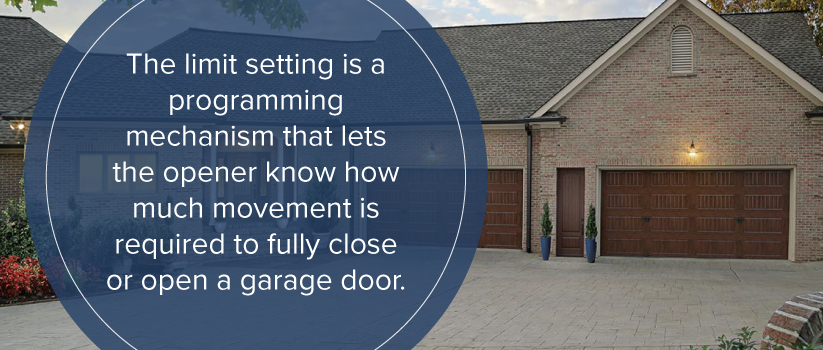
If the settings are too high, the opener will think that a door has closed prematurely when it touches the ground and, therefore, mistake the ground for an obstruction. Since openers are programmed not to close on foreign objects, the door will automatically reverse itself. If your door behaves in this way, have a maintenance specialist inspect the limit settings on your garage door opener and make adjustments if needed.
9. The Door Track Is Misaligned
When it comes to the workings of a garage door system, the operating mechanisms activate the door, and the cables lift and lower it physically while the springs manage the tension. However, none of these actions could possibly remain centered along the garage doorway and ceiling if not for the metal tracks that keep the door in line. Therefore, the tracks that guide the door must be straight and even on both sides.
If either track becomes slightly ajar, it can slow the movement of the door. As time goes on, the problem is liable to get worse. For instance, a bend at any point along one side is bound to pull on the door, which, in turn, will put pressure on the other side and effectively duplicate the problem on the mirroring track.
Pressure and natural wear and tear can cause misaligned door tracks. Always call a service to get these tracks replaced and get your garage door working again.
If one or both tracks is bent, you might hear a squeaking sound as the rollers pass the affected area. The movement of the door might slow just slightly as it passes this spot. A problem like this can grow out of hand as the months wear on, and the weight of the door causes further stress. If you know or even sense that your door tracks have lost their alignment, call a service specialist immediately.
Learn More About Our Garage Door Repair Services
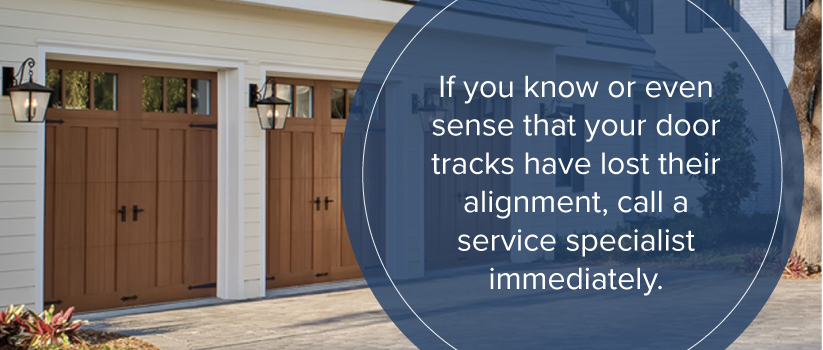
10. A Tiny Obstacle Is Present
If a door reverses upon closing, there could be something in the way that poses as an obstruction. This does not necessarily have to involve the photo-eyes, either. Various items that would fall below the beam of the photo-eye can cause a door to reverse itself, such as foliage, paper and even used gum.
After all, a door is programmed to only close on solid ground and reverse course if anything foreign is encountered along the way.
If your garage door keeps reversing, a tiny object, dirt or foliage is likely obstructing the door. If you remove all the obstructions and the door is still reversing, you should call a service.
Obstructions that homeowners often overlook are not just found on the ground, as the tracks can also get lined with items that could halt and reverse the closing of a door. If gum, dirt or foliage get lodged into one of the tracks at any point, the door might automatically reverse on contact. To prevent this from happening, inspect the tracks about twice a year, and clean them if necessary.
11. The Motor Has Been Deactivated
Sometimes when a garage door won't open or close, it does not actually mean there is anything wrong with the door, your remote or even one of the opener-assembly parts. The issue could all boil down to the simple goof of a disconnected motor. To solve this, you can reconnect the motor.
The motor switch is there so you can open a garage door without the opener in the event of a power outage. Sometimes, however, the cord that connects to the motor switch will get caught and pulled, thus disabling the motor.
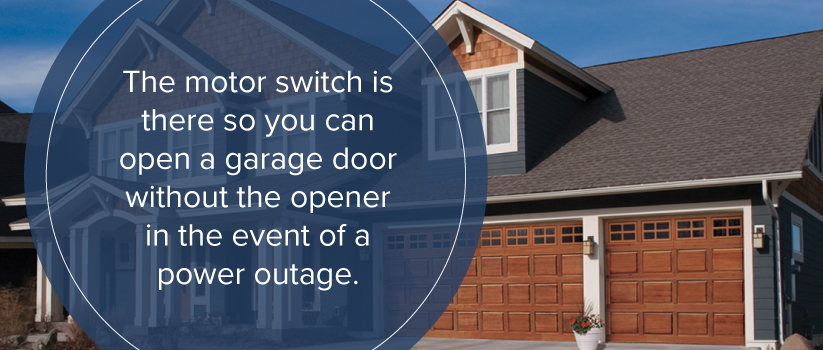
In some instances, it might be because of human error. Have you ever inadvertently pulled a cord or flipped a switch? That very action could be the source of your problem.
12. Lock Mode Has Been Inadvertently Activated
If you return home to find that your garage door won't open as prompted, it might be because you held the button down too long as you were leaving. Sometimes human error causes a stuck garage door. Pushing the lock button is a minor error with a quick fix.
With some garage openers, a feature exists that allows you to put the opener in lock mode. You can activate this feature by holding down the button on your keypad for several seconds. Once locked, a normal press of the button will not activate the door. To bring the door out of lock mode, simply hold the button down again for several seconds.
13. The Door Has Been Locked Manually

If nothing appears to be wrong with the opener, yet the garage door won't open, you might have unintentionally locked it manually. A tell-tale sign is when the motor momentarily runs when prompted but then shuts off without raising the door.
Manual locking is another reason your garage door can get stuck. You can easily solve this by disengaging the lock.
Some garage doors are equipped with manual locks, which typically look like handles with horizontal bars. When the manual lock is engaged, the garage door will not activate. While the feature exists for an added layer of security, people sometimes activate these locks unintentionally while performing tasks near the door. For example, if you are pulling something out of the trunk of your car and have your back to the door, you could easily hit the lock and not even know.
To unlock the door, turn the handle until you hear it make a snap. This will disengage the horizontal bar and allow you to activate the door.
14. Stripped Gear in the Opener
As a garage door assembly ages, the stress of daily activity can have a cumulative effect on the opener. Once the gear becomes stripped, the opener will no longer function.
Like springs and cables, gears can wear down, too. A stripped gear is a major problem, and you'll want to call a service to get the opener replaced.
A common giveaway is when the opener makes a humming noise when prompted but won't open. In some cases, the gears can be replaced. Often, however, the only way around a stripped gear is a new opener. In the meantime, use of the door must be limited to manual activation. In any case, the replacement of your opener should only be performed by a garage door service professional.
15. The Keypad Is out of Sync
The remote is not the only activation device that sometimes needs to be reset. If your remote works but the keypad doesn't, it might be time to reset the code. In most cases, this issue can easily be handled with the help of a user's manual. You could also consult a troubleshooting guide to address the problem.
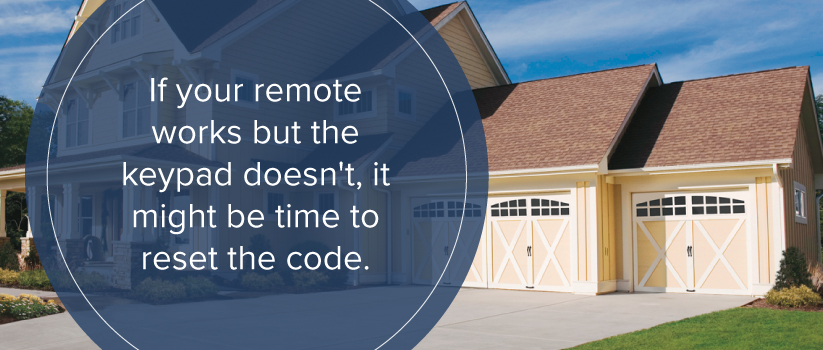
Contact Marvin's Garage Doors for Service
As the largest, heaviest and most technologically complex entrance to your home, the garage door is one of the most important security features of your house. Whenever your garage door fails to function as expected, the problem should be serviced as soon as possible.
Marvin's Garage Doors provides 24-hour emergency service for homes in the Winston-Salem, Wilkesboro and Piedmont Triad of North Carolina. Contact Marvin's Garage Doors whenever you need service for your garage door.
Source: https://marvinsgaragedoors.com/2021/12/15/reasons-garage-door-wont-open-close/
0 Response to "When Garage Door Closes Does Need to Wait Before Opening Again"
Post a Comment